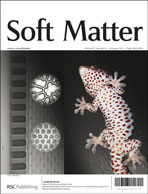Exploring adipogenic differentiation of a single stem cell on poly(acrylic acid) and polystyrene micropatterns
Abstract
Surface chemistry is an important property of biomaterials and plays a pivotal role in the interaction between stem cells and biomaterials. Comparing the effect of the surface chemistry at the single-cell level should elucidate the mechanism of the interaction. In this study, a micropatterning method was used to investigate the electrostatic effect derived from different chemical groups on the functions of individual human mesenchymal stem cells (MSCs). Differently sized circular micropatterns of negatively charged poly(acrylic acid) (PAAc) and neutral polystyrene (PSt) were created using UV


 Please wait while we load your content...
Please wait while we load your content...